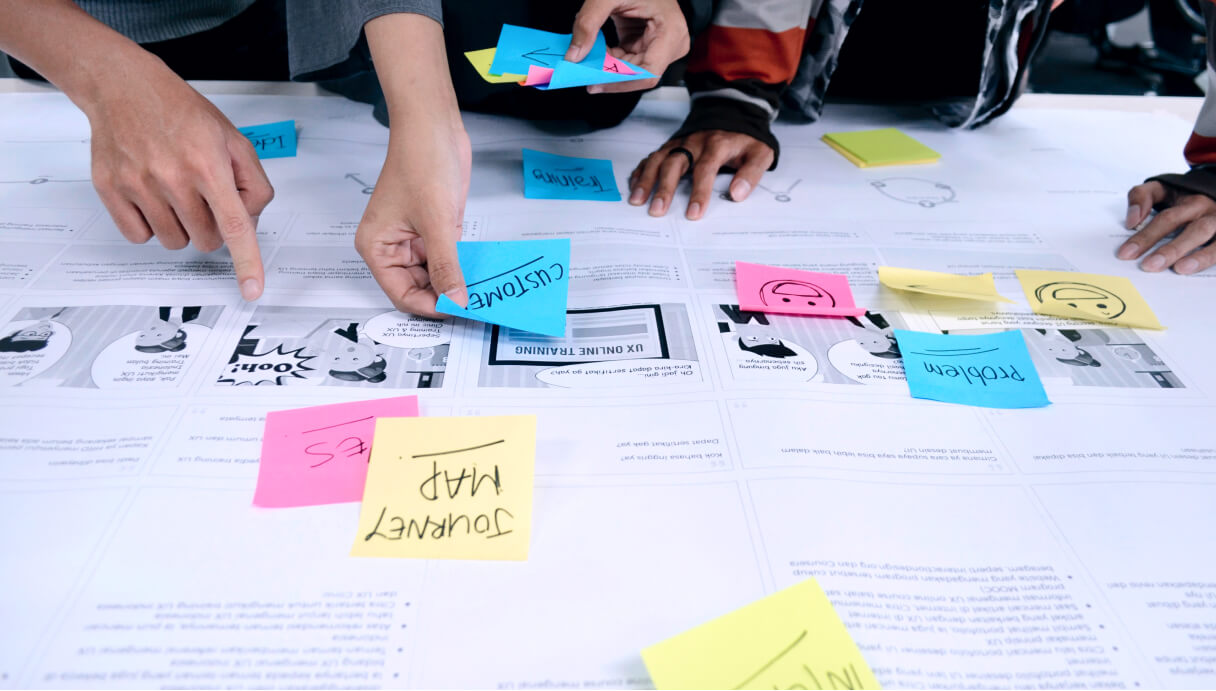What is service design and why your business need it?

Competition is so intense in every industry that businesses are leveraging service as their competitive advantage. Even those organizations that cannot articulate answers to questions like ‘What is the value of service design’ understand that they must reinforce their service if they wish to grow, or even survive.
A car manufacturing company, for instance, will train their dealers in order to make sure they provide great service to car buyers. An investment consultant, on the other hand, will provide not only the right advice to their client but also serve information in the most easily understandable format. In both these cases, the focus is on building a great experience through service design.
What is service design?
Service design can be defined as the set of activities that engages people, processes, technology and data in order to improve service and optimize customer experience before, during and after the procurement of the offerings of an organization.
In simpler words, service design is making sure that every touch point of the customer journey is smooth and pleasant. Imagine you’re considering getting an oriental massage at the new spa in your city. Everything from learning about the various massages and booking online for a massage session to having the massage and receiving tips on how to prolong the pleasant effects of the massage – all this will fall under service design.
If this reminds you of UX, you’re not alone. However, the two are distinct, though a number of elements do overlap.
Difference between service design and UX
As mentioned above, it’s not difficult to confuse service design with user experience (UX). Both of them focus on making things pleasant, simple and memorable for the user.
The most important difference between the two is perhaps the scope. UX focuses on individual touchpoints. For example, when you collect information about a particular massage type from the website of the spa, how the website makes you feel is the UX. Service design, on the other hand, considers this as one of the many steps of the entire journey.
Besides, service design can include even the concrete elements: physical infrastructure, design layout of the spa and all that. In contrast, UX is almost exclusively digital.
Finally, UX will rely heavily upon wireframes and page layout and all that. Against that, service design is interested more in the buyer persona and what the buyer does before and after availing the service.
The importance of service design
When you are pitching for the service design process, you’ll meet people within the organization who aren’t fully convinced you should be doing it. You’ll be asked what is the purpose of service design and how it will change things.
The answer is quite long, so we’ll restrict ourselves to just two factors:
- Service design builds an organization-wide commitment to remain loyal to customer needs. Your teams not only stop wasting time on things that aren’t important to customers but can put in more energy into things that matter to customers. Different departments can join hands and make the entire process highly efficient.
- Service design breaks down the disconnect between what you offer and what the customers are looking for. The smaller this gap, the bigger the value you’re creating for the customer. It’s like your customer and you have clearly agreed upon something and you’re delivering just that.
Service design process
Today, it’s easier than before to connect with your buyers and try and figure out how they feel about your brand. That’s very important, because in the service design process, the customer is at the center.

The process is a major exercise in itself that requires deep study. Here, however, we present a brief overview of the service design process.
1. Understand and define what your service stands for
Your service design process begins by you asking yourself what your service and your brand stand for. Are you super-premium? Are you value-for-money? Does your brand represent the spirit of adventure? Is your service meant to usher change or preserve stability?
2. Conduct research about customer journey and customer aspirations
Almost nothing that relates to an organization can be achieved without bringing in focus how customers would be impacted. Work on understanding where your customers come from and where your service takes them to. Map their journey, carefully understanding their challenges and aspirations.
3. Identify points in the customer journey for potential service opportunities
No matter how awesome your current service is, you’ll always see room for improvement. But service design is not just about improvement; it’s also about finding gaps. Is there an area you’re completely missing?
4. Align these opportunities with organizational goals
In an extremely competitive world – which is practically all markets today – it’s easy to pin down a lot of things to quick-fix measures like a price cut. However, be sure to stake up all the proposed changes and improvements against your organization’s mission. Depending upon how you’ve positioned your brand, a price-cut can damage your brand.
5. Bring in the POV of all the stakeholders
Customers are the centre of your universe, but there are other stakeholders that are important too. The service delivery team, for instance, has a direct window to your customers. Your suppliers,for instance, can tell you about the logistics constraints. Discuss with all of them what the service design ultimately aims to achieve and accommodate their point of view.
6. Summarise the resources available and clarify additional resources required
In an ideal situation, all problems can be solved with the right resources. In reality, however, you never have access to everything. Therefore it’s important to understand the resources you have on hand before you go to the drawing board and chalk out your new service plan.
7. Redesign the service, with a particular emphasis on delivery teams
Okay, so you now know what you stand for, what your customers want and what resources you have available. Now you can sit down and document your service design. At this stage too, you’ll want to understand and probably involve the delivery teams. That’s because ultimately it’s them who’re going to deliver, not you.
8. Set down clear KPIs
Often, well-designed plans ‘fail’ because someone was measuring the wrong item all along. Along with designing the service, it’s important to lay down and agree upon the KPIs against which you’ll be measuring the success of the service. Be sure to get the right buy-ins.
9. Chalk out training requirements for change management
You’re talking about improvement and improvement means change. Not everything can undergo change smoothly or automatically. It’ll be your duty to see that the training requirements are all jotted down in detail. Also, you’ll have to map out the shortfalls in skills required to deliver the service and decide upon training programs that will help deliver the service you’re looking for.
10. Evaluate and iterate
Even after you’ve begun delivering the new service model, your job’s still not done. You must constantly study your customers (and your delivery teams) to see the outcomes. Record all the places you’ll need to improve. Be sure to keep the learning process iterative. Remember, everything you do should ultimately boil down to improving the service for your customer.
Benefits of service design
Organizations are finding service design increasingly important in today’s scenario. In fact, one of the main advantages of service design is that it can help you improve your USP even in an otherwise cluttered, undifferentiated market.
Here are the top four benefits of service design:
1. It hugely improves the spirit of empathizing with the customer
It’s important to note that service design is one of those rare business functions that truly keep things customer-centric. Strategic and tactical decisions, action plans and even training programs are outlined keeping the customer in mind.
All this requires you to closely understand the customer. You want to understand what drives them, what troubles them and what aspirations motivate their actions. You need to try and unravel the real face of the customer, the real reason they’re making a purchase.
2. It makes service delivery more efficient
In hindsight it sounds silly, but more organizations than you’d believe use the approach of ‘Throw and see what sticks’ – basically a hit and trial approach to serving customers. That not only makes a lot of unfounded assumptions, but, more importantly, wastes organizational resources.
With a clear-cut understanding of your customer, your service delivery process becomes highly efficient. You are not making choices on behalf of the customer so what’s coming out of your service design room is a great deal more relatable for the customer. All resources are aligned towards the correct goal.
3. Service design increases value delivered – and drives growth
The service design process requires you to nail customer needs. That means it’s easier for you to offer value, since you know what the customer thinks is ‘value’. In turn, your overall service design increases in value, which means you’ll be able to build growth on a stronger footing.
When customers get more of what they want, they’re willing to pay more than what they’d otherwise pay. Put differently, stronger service design can help you collect a premium over regular pricing.
4. Service design strengthens your brand
An organization that understands how and what kind of service needs to be created and delivered is in a stronger position in any market. That’s obvious because whatever you’re doing to improve your service isn’t coming from your ivory towers, it’s coming straight from the customers.
Customers can see that everything you’re doing is a reflection of their desires, their requirements, their needs. They realize you are investing not only in understanding them but also in delivering what they want.
Conclusion
Because service is how you make your customers feel, it’s only natural that your teams work hard to make the experience great. A strong service design framework will enable your teams to constantly improve the outcomes, no matter how often the bar is raised.
Businesses are realising the tremendous value that consultants can bring. These consultants can help them realize the advantages of service design. With our experience and clear understanding of how various tools can augment your service delivery, our team of experts can help you at every stage, from primary evaluation to execution and implementation.
Let us know where you’d like to begin and we’ll get back to you.
Case Studies
Let our work do the talking
Learn about the instances where we were able to create an impact, raising the bar on the standards we set for ourselves.

88&8 —Design, It’s all about trust.
Power of design to create possibilities that
define a preferable future for companies,
cities and societies.
Insights
The information technology times
Have a read on groundbreaking figments of imagination of the brightest minds that have been brought to life.
How can we help you?
Get in touch and let’s find out how we can curate our offerings to match your organization’s needs.
Get in touchSign up for our latest insights.
Never miss an insight. We’ll email you when new articles are published.
Subscribe.
Thanks for subscribing to PiServe Insights.
Please fill in the details.










